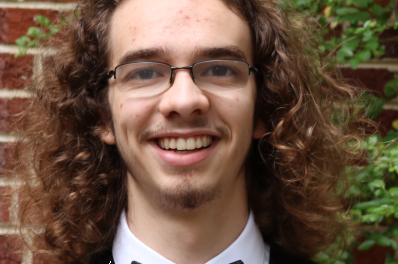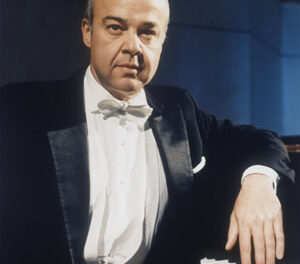Recently new artist/faculty member Taimur Sullivan presented a wide-ranging collection of works for saxophone in his first recital in Watson Hall at the University of North Carolina School of the Arts. Sullivan is well-known in the saxophone world: a member of the acclaimed PRISM Quartet and former faculty member of Columbia University, he has premiered over a hundred new works for saxophone, which may explain much of the repertory we heard tonight.
The saxophone is a late-comer in the musical family, patented by Belgian instrument-maker Adolph Sax as recently as 1846; Beethoven, Schubert, and Mozart had all died before its invention, and some later composers such as Brahms and Wagner distained to write for it. However, its popularity began in the 1840s when Berlioz, always the innovator, heard it and wrote an article championing it. He was also the first important composer to have used the new instrument in his orchestrations, followed by Bizet (whose incidental music for Alphonse Daudet’s l’Arlesienne, using the saxophone, will be featured on the UNCSA student orchestra concert on Friday, October 25th in the Stevens Center).
Be that as it may, Taimur Sullivan is a virtuoso and an artist! His warm liquid tone is golden, and his control of the instrument, especially in the softest passages, is phenomenal. He is as “at home” on the baritone saxophone, the often-croaky bass of the sax quartet, as on the alto, and impressive on the soprano. (There are also larger/lower and smaller/higher variants as well as the tenor sax, which sits near the middle, both in size and tessitura. Saxophones, though they vary in size and therefore range, have the same fingering but different reeds and mouthpieces.)
The concert opened with one of the earliest works (1855) in the sax literature, the “Fantaisie sur des motifs du Freischütz,” a theme and set of variations from the popular opera by Carl Maria von Weber for alto saxophone and piano. From the very onset of the concert, one admired the tone and vibrato, as well as Sullivan’s technical wizardry.
In the charming tribute to the blonde bombshell of the 1930s, Jean Harlow, “Épitaphe,” by Parisian composer and pedagogue Charles Koechlin (1867-1950), pianist Allison Gagnon had handsful of notes and arpeggios to accompany flutist Tadeu Coelho. Most impressive was the ability of the alto sax in all registers to balance the flute, usually loud only in the upper register — no mean talent for a musician whose instrument is sometimes viewed as a brass instrument with a reed!
Starting with the first three notes of R. Strauss’ “Til Eulenspiegel” (political commentary?), the next piece was provocatively entitled, “Election Year” (1994), for solo alto saxophone, by North Carolina native Benjamin Boone (b.1963), currently a resident of California. This seven-minute work is in a style most would call “Modernist” or “Pointillist,” with notes and effects scattered over wide ranges and played at unpredictable moments. Among the effects were altering the tone by over-blowing the reed, or flutter-tonguing, and singing while playing, an effect occasionally used by other wind instruments when out on a contemporary limb.
The first half ended with the more main-stream Sonata, Op. 29 (1970), by Arizona native Robert Muczynski. Originally titled “Desert Sketches” because of the composer’s love of the desert wilderness, the two movements, Andante maestoso and Allegro energico, are evocative of “Night” and “Prey.” This second movement, with its fast-paced syncopations, evoked visions of a mortal chase. The quickly-tongued triplets near the end of the chase reminded one that the saxophone is primarily a lyrical instrument, not often given to spitting out quick, short musical invectives.
The “tuxes came off” with one of Russia’s leading contemporary composers, Sofia Gubaidulina (b.1931), opening the second half of the concert with her Duo Sonata (1977) for two low instruments. Originally composed for two bassoons and later re-written by the composer for two baritone saxophones, this hybrid version featured one of each — bari’ and bassoon — in what proved to be the most intriguing work of the evening. Sullivan introduced the excellent new bassoon faculty member Saxton Rose to the audience and both, shorn of their jackets, attacked this interesting if somewhat lugubrious work. Gubaidulina seems interested in probing and exploring the intimacy of every sound and interval, the closer the better — she trilled, altered by 1/4-tones, and fluttered and saturated sounds, all while maintaining rising and falling arches of pitch and intensity. The insistence of the bari’ resists the petulance of the bassoon, and suddenly, silence!…. The bassoon, in its castrato register trumps the saturated sax, moments of calm alternating with periods of fierce energy and 1/4-tone trills attacked by and then caressing the baritone sax’s multiphonics (multiple notes sounding from the same instrument, akin to, but less clean than, double-stops on string instruments).
This is interesting music, with shape and form; it is hard to understand but written in a human, non-mechanical language. I would like to hear one of the original versions, because the difference of the timbres of the two instruments in this hybrid allowed extraneous personalities to develop, whereas with both voices being played by like instruments, the tensions and calms of the piece itself would be highlighted.
The two last works on the program are both electroacoustic compositions featuring a saxophone with a pre-composed (“taped” or electronically stored) accompaniment. The first of these, “Tárogató!” for soprano saxophone and tape (1998), by Texan composer Larry Austin (b.1930), is based on pre-recorded and computer-manipulated eight-track sounds of a traditional Hungarian wind instrument, not unlike the soprano saxophone which Sullivan played in place of a tárogató. Antique tárogatós were double reed instruments (like oboes), but the modern instruments’ reeds resemble clarinet or saxophone reeds.
“Tárogató!” is a haunting piece in which the soloist follows the lead of the instrument on tape, using devices like echoes, responses, imitation, and drones which surround the listener, who wallows in slow oscillations coming and going. Toward the midpoint of the 12-minute piece, the drones cut out and the soprano sax becomes quite animated. Trading place with the background, the soloist then takes his turn to play the soulful plaintive tune heard at the opening, and the recorded tárogató is the follower in the canon that closes the work. [Listen here: http://artofthestates.org/cgi-bin/piece.pl?pid=164 [inactive 9/09].]
The closing work of this concert, “Billie” (2003), by Dutch composer Jacob ter Veldhuis (b.1951), is composed of short snippets of Billie Holiday speaking — the complete text was in the program notes, but with all the lights off except a small lamp on stage, one couldn’t follow along. Snippets and musical tones were repeated frequently in a style akin to minimalism, and from the background one could pick out the pizzicato of a string bass, some percussion, and a synthesizer. Everything, including the alto saxophone, was very precisely put together. And until near the end, sound bytes of music were separated by silence. Eventually, the live sax in the hall played a duet with the taped sax, coming to many false endings before eventually stopping. Sullivan has recorded this piece on the PRISM Quartet’s CD, Pitch Black.












